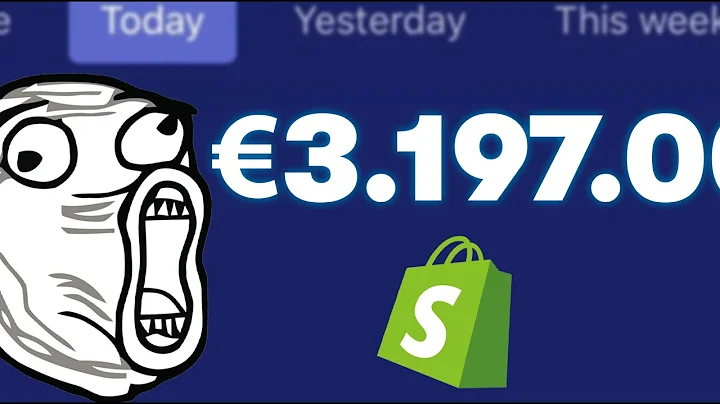Trouvez un fournisseur de dropshipping local pour votre boutique en ligne
Table of Contents:
- Introduction
- The Problem with Overseas Suppliers
- Introducing a Local Solution
- The Benefits of Working with Local Suppliers
- How to Get Started with Zero Supply
- Registering and Setting Up Your Account
- Navigating the Marketplace
- Importing Products to Your Shopify Store
- Managing Orders and Payments
- Advanced Features of Zero Supply
- Product Analytics and Finding Winning Products
- High Margin Products and Luxury Goods
- Messaging Suppliers and Sourcing Requests
- Conclusion
Introduction
For many online store owners, sourcing products from overseas suppliers has been a long-standing challenge. Issues such as poor quality, long shipping times, and unreliable suppliers have made the experience frustrating and costly. However, there is a solution that can change the way you work with suppliers for your online store. In this article, we will discuss Zero Supply, a platform that connects you with local suppliers in France and Europe, offering faster shipping times, reliable products, and the possibility of customization.
The Problem with Overseas Suppliers
One of the major issues faced by online store owners is the reliance on suppliers from China, such as Alibaba and AliExpress. While these platforms offer a wide range of products at competitive prices, the quality is not always guaranteed. Additionally, there are often delays in shipping, packages that are not delivered, and unreliable packaging. The overall delivery experience for customers is poor, and it does not seem to be improving. After years of working with these overseas suppliers, it has become evident that a new approach is needed.
Introducing a Local Solution
After months of research and development, Zero Supply has emerged as a game-changer for online store owners. The platform connects you with local suppliers in France, Europe, or near your customers who are willing to work with you through dropshipping. These suppliers not only provide faster shipping times, but they also ensure the quality of their products. Furthermore, they offer the option for custom packaging and even personalized products, giving you the opportunity to create a unique brand experience for your customers.
The Benefits of Working with Local Suppliers
Working with local suppliers through Zero Supply offers several advantages. Firstly, the shipping times are significantly reduced, with delivery times of less than a week. This allows you to provide a better customer experience and potentially increase customer satisfaction and loyalty. Secondly, as you build a stronger relationship with the suppliers, you have the possibility of having your own branded packaging and even requesting customized products. This level of personalization can give your online store a competitive edge and help you stand out in the market.
How to Get Started with Zero Supply
To get started with Zero Supply, you need to register and set up your account. The process is straightforward and can be done through the Zero Supply website. Once you have created your account, you will have access to the Marketplace, where you can find a wide range of products for your online store. The platform offers various ways to search for products, including categories and a search bar. It is important to note that the search function currently works best with English keywords.
Navigating the Marketplace
Once you are in the Marketplace, you can browse through different categories or use the search bar to find specific products. Each product listing provides details such as pricing, recommended selling price, shipping information, and a description. You can also view images of the product to get a better idea of its appearance and quality. If you find a product that aligns with your store's offering, you can easily import it to your Shopify store with just a few clicks.
Importing Products to Your Shopify Store
Importing products from Zero Supply to your Shopify store is a simple process. By clicking on the "Add to Import List" button, you can add the desired products to your import list. From there, you can review and edit the product details before importing them to your Shopify inventory. Once imported, the products will appear in your Shopify store, ready to be marketed and sold to your customers.
Managing Orders and Payments
When a customer places an order on your Shopify store for a product imported from Zero Supply, the order will be automatically synced with Zero Supply. This allows you to easily manage and process the order through the Zero Supply platform. You can choose to pay the supplier directly if they are registered with Zero Supply, or you can use the Catalogify extension to place the order. The seamless integration between Zero Supply and Shopify ensures that the supplier receives all the necessary information to fulfill the order efficiently.
Advanced Features of Zero Supply
Beyond the basic features, Zero Supply offers several advanced functionalities to enhance your e-commerce experience. One of these features is product analytics, which allows you to analyze the performance of products in terms of sales, visits, popularity, and more. This data can help you identify winning products and make informed decisions about your inventory. Additionally, Zero Supply provides a selection of high-margin products, including luxury goods, that can generate higher profits for your store.
Messaging Suppliers and Sourcing Requests
Communication with suppliers is crucial for a successful partnership. Zero Supply allows you to send messages directly to suppliers registered on the platform, ensuring clear and efficient communication. You can also submit sourcing requests if you cannot find a specific product in the Marketplace. The team at Zero Supply will help you find suitable suppliers and products to meet your needs.
Conclusion
Zero Supply offers a solution to the challenges faced by online store owners when working with overseas suppliers. By connecting you with local suppliers in France, Europe, or near your customers, Zero Supply provides faster shipping times, reliable products, and customization options. The platform's advanced features, such as product analytics and high-margin products, further enhance the e-commerce experience. With its user-friendly interface and seamless integration with Shopify, Zero Supply is a valuable tool for online store owners looking to improve their sourcing and fulfillment processes.
Highlights:
- Zero Supply connects online store owners with local suppliers, providing faster shipping times and reliable products.
- Working with local suppliers allows for customization and branded packaging options.
- Zero Supply offers advanced features such as product analytics and high-margin products.
- Seamless integration with Shopify makes it easy to import and manage products.
FAQ:
Q: How does Zero Supply differ from working with overseas suppliers?
A: Zero Supply connects you with local suppliers, offering faster shipping times and better quality products compared to overseas suppliers.
Q: Can I customize my packaging and request personalized products with Zero Supply?
A: Yes, working with local suppliers through Zero Supply allows for custom packaging and the possibility of requesting personalized products.
Q: Can I import products from Zero Supply directly to my Shopify store?
A: Yes, Zero Supply seamlessly integrates with Shopify, making it easy to import products to your store.
Q: Does Zero Supply provide product analytics?
A: Yes, Zero Supply offers product analytics to help you identify winning products and make informed inventory decisions.
Q: Can I communicate directly with suppliers through Zero Supply?
A: Yes, Zero Supply allows you to send messages directly to suppliers and submit sourcing requests.
Q: What are the benefits of using Zero Supply for online store owners?
A: Zero Supply offers faster shipping times, reliable products, customization options, and advanced features such as product analytics and high-margin products.












![Les 10 meilleurs produits gagnants à lancer en dropshipping [Septembre 2023]](https://i.ytimg.com/vi/MeVkDFI4hD8/hq720.jpg?sqp=-oaymwEcCNAFEJQDSFXyq4qpAw4IARUAAIhCGAFwAcABBg==&rs=AOn4CLDnFckj27HkJaD1cQV9FpMA-I_E-A)






